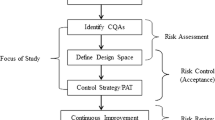Abstract
This study showed near Infrared (NIR) and Raman spectroscopy with a multivariate calibration approach were very effective to determine blend uniformity end-point. A set of 36 trimebutine samples containing magnesium stearate, stearic acid, colloidal silicon oxide, talc as excipients (0.9%∼1.8%) was acquired from six positions during blending processing with U-type blender from 0 to 30 min. Principle component analysis (PCA) with NIR and Raman spectral data was used to confirm the end-point of blending. After 30 min, the scores of principle component (PC) 1 and principle component (PC) 2 for samples moved into one point, which clearly indicated the mixture of sample became homogenous. In addition, NIR and Raman spectroscopy has been applied to the quantitative analysis of 20 trimebutine samples containing 2∼40% in mixture granules, which divided into a calibration set of 15 samples and a prediction set of 5 samples for NIR spectral data. The standard error of calibration (SEC) and standard error of prediction (SEP) are 0.15% and 0.13%, respectively using NIR while SEC and SEP of 0.95% and 0.91% are obtained using Raman spectroscopy. The results showed the NIR and Raman spectroscopy with a multivariate calibration such as PCA and PLS provide the possibility of real time monitoring of homogeneity and content uniformity during blending process.
Similar content being viewed by others
References
Beebe, K. R. and Kowalski, B. R., An introduction to multivariate calibration and analysis. Anal. Chem., 59, 1007A–1017A (1987).
Beebe, K. R., Pell, P. J., and Seasholtz, M. B., Chemometrics: A Practical Guide, John Wiley and Sons, New York, (1998).
Burns, D. A. and Ciuczak, E. W., Handbook of Near-Infrared Analysis, 3rd ed., CRC Press, New York, (2008).
De Beer, T. R. M., Baeyens, W. R. G., Ouyang, J., Vervaet, C., and Remon, J. P., Raman spectroscopy as a process analytical technology tool for the understanding and the quantitative in-line monitoring of the homogenization process of a pharmaceutical suspension. Analyst, 131, 1137–1144 (2006).
De Beer, T. R. M., Alleso, M., Goethals, F., Coppens, A., Vander Heyden, Y., de Diego, H. L., Rantanen, J., Verpoort, F., Vervaet, C., Remon, J. P., and Baeyens, W. R. G., Implementation of a process analytical technology system in a freezedrying process using Raman spectroscopy for in-line process monitoring. Anal. Chem., 79, 7992–8003 (2007).
Donoso, M. and Ghaly, E. S., Use of near-infrared for quantitative measurement of viscosity and concentration of active ingredient in pharmaceutical gel. Pharm. Dev. Technol., 11, 389–397 (2006).
El-Hagrasy, A. S. and Drennen, K., A process analytical technology approach to near-infrared process control of pharmaceutical powder blending, Part III: Quantitative near-infrared calibration for prediction of blend homogeneity and characterization of powder mixing kinetics. J. Pharm. Sci., 95, 422–434 (2006).
El-Hagrasy, A. S., D’Amico, F., and Drennen, J. K., A process analytical technology approach to near-infrared pocess control of pharmaceutical powder blending, Part I: Doptimal design for characterization of powder mixing and preliminary spectral data evaluation. J. Pharm. Sci., 95, 392–406 (2006a).
El-Hagrasy, A. S., Delgado-Lopez, M., and Drennen, J. K., A process analytical technology approach to near-infrared process control of pharmaceutical powder blending, Part II: Qualitative near-infrared models for prediction of blend homogeneity. J. Pharm. Sci., 95, 407–421 (2006b).
Hwang, M. S., Cho, S., Chung, H., and Woo, Y.-A., Nondestructive determination of ambroxol content in tablets by Raman spectroscopy. J. Pharmaceut. Biomed., 38, 210–216 (2005).
Kim, J., Noh, J., Chung, H., Woo, Y.-A., Kemper, M. S., and Lee, Y., Direct, non-destructive quantitative measurement of an active pharmaceutical ingredient in an intact capsule formulation using Raman spectroscopy. Anal. Chim. Acta, 598, 280–285 (2007a).
Kim, M.-J, Chung, H., Woo, Y.-A., and Kemper, M. S., New reliable Raman collection system using the wide area illumination (WAI) scheme combined with the synchronous intensity correction standard for the analysis of pharmaceutical tablets. Anal. Chim. Acta, 579, 209–216 (2006).
Kim, M.-J, Chung, H., Woo, Y.-A., and Kemper, M. S., A new non-invasive, quantitative Raman technique for the determination of an active ingredient in pharmaceutical liquids by direct measurement through a plastic bottle. Anal. Chim. Acta, 587, 200–207 (2007b).
Lewis, Ian R., Edwards, and Howell G. M., Handbook of Raman spectroscopy: from the research laboratory to the process line, Marcel Dekker, New York, (2001).
Martens, H. and Naes, T. M., Multivariate Calibration, Wiley and Sons, New York, (1989).
McGoverin, C. M., Rades, T., and Gordon, K. C., Recent pharmaceutical applications of Raman and teraherz spectroscopies. J. Pharm. Sci., 97, 4598–4621 (2008).
Park, S. C., Kim, M., Noh, J., Chung, H., Woo, Y.-A., Lee, J., and Kemper, M. S., Reliable and fast quantitative analysis of active ingredient in pharmaceutical suspension using Raman spectroscopy. Anal. Chim. Acta, 593, 46–53 (2007).
PAT Guidance for Industry: PAT-A framework for innovative pharmaceutical development, manufacturing and quality assurance, http://www.fda.gov (2004).
Process Analytical Technology (PAT) Initiative, Office of Pharmaceutical Science (OPS), http://www.fda.gov.
Sasic, S., Pharmaceutical Applications of Raman Spectroscopy, John Wiley & Sons, New Jersey, (2007).
Walker, G. M., Bell, S. E. J., Greene, K., Jones, D. S., and Andrews, G. P., Characterization of fludized bed granulation processes using in-situ Raman spectroscopy. Chem. Eng. Sci., 64, 91–98 (2009).
Woo, Y. A., Content uniformity in granules for aceclofenac controlled release (CR) tablets determined using nearinfrared spectroscopy and wide area illumination (WAI) Raman spectroscopy. Arch. Pharm. Res., 35, 351–358 (2012).
Author information
Authors and Affiliations
Corresponding author
Additional information
These authors contributed equally to this work.
Rights and permissions
About this article
Cite this article
Lee, SH., Lee, JH., Cho, S. et al. End point determination of blending process for trimebutine tablets using principle component analysis (PCA) and partial least squares (PLS) regression. Arch. Pharm. Res. 35, 1599–1607 (2012). https://doi.org/10.1007/s12272-012-0911-3
Received:
Revised:
Accepted:
Published:
Issue Date:
DOI: https://doi.org/10.1007/s12272-012-0911-3




